Hyundai H350 2015 Service Manual
Manufacturer: HYUNDAI, Model Year: 2015, Model line: H350, Model: Hyundai H350 2015Pages: 473, PDF Size: 26.4 MB
Page 41 of 473
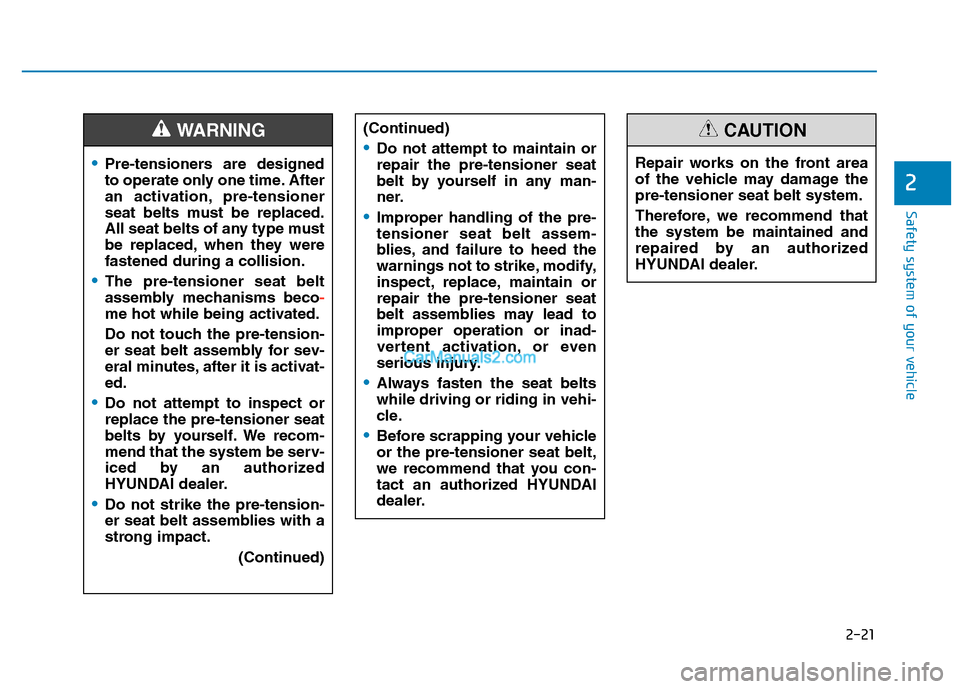
2-21
Safety system of your vehicle
2
Pre-tensioners are designed
to operate only one time. After
an activation, pre-tensioner
seat belts must be replaced.
All seat belts of any type must
be replaced, when they werefastened during a collision.
The pre-tensioner seat belt
assembly mechanisms beco
-
me hot while being activated.
Do not touch the pre-tension-
er seat belt assembly for sev-
eral minutes, after it is activat-ed.
Do not attempt to inspect or replace the pre-tensioner seat
belts by yourself. We recom-
mend that the system be serv-
iced by an authorized
HYUNDAI dealer.
Do not strike the pre-tension-
er seat belt assemblies with a
strong impact.(Continued)
WARNING (Continued)
Do not attempt to maintain or repair the pre-tensioner seat
belt by yourself in any man-
ner.
Improper handling of the pre- tensioner seat belt assem-
blies, and failure to heed the
warnings not to strike, modify,
inspect, replace, maintain orrepair the pre-tensioner seat
belt assemblies may lead to
improper operation or inad-
vertent activation, or even
serious injury.
Always fasten the seat belts while driving or riding in vehi-
cle.
Before scrapping your vehicle or the pre-tensioner seat belt,
we recommend that you con-
tact an authorized HYUNDAI
dealer.
Repair works on the front area
of the vehicle may damage thepre-tensioner seat belt system.
Therefore, we recommend that the system be maintained and
repaired by an authorized
HYUNDAI dealer.
CAUTION
Page 42 of 473
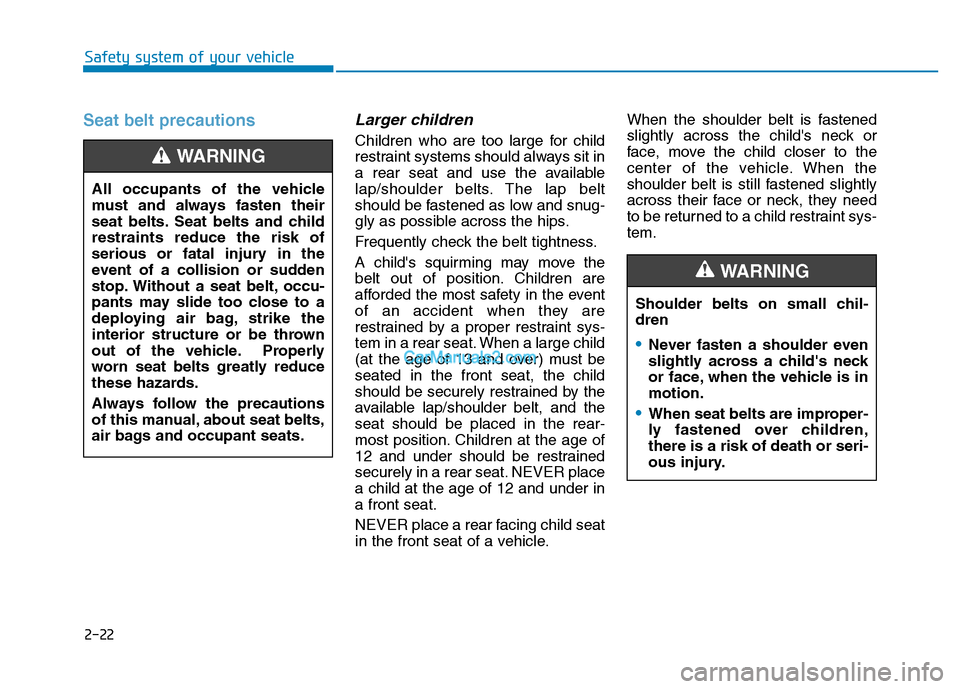
2-22
Safety system of your vehicle
Seat belt precautionsLarger children
Children who are too large for child
restraint systems should always sit in
a rear seat and use the available
lap/shoulder belts. The lap belt
should be fastened as low and snug-
gly as possible across the hips.
Frequently check the belt tightness.
A child's squirming may move the
belt out of position. Children are
afforded the most safety in the event
of an accident when they are
restrained by a proper restraint sys-
tem in a rear seat. When a large child
(at the age of 13 and over) must beseated in the front seat, the child
should be securely restrained by the
available lap/shoulder belt, and theseat should be placed in the rear-
most position. Children at the age of
12 and under should be restrained
securely in a rear seat. NEVER placea child at the age of 12 and under ina front seat.
NEVER place a rear facing child seat
in the front seat of a vehicle.When the shoulder belt is fastened
slightly across the child's neck or
face, move the child closer to the
center of the vehicle. When the
shoulder belt is still fastened slightly
across their face or neck, they need
to be returned to a child restraint sys-tem.
All occupants of the vehicle
must and always fasten their
seat belts. Seat belts and childrestraints reduce the risk of
serious or fatal injury in the
event of a collision or sudden
stop. Without a seat belt, occu-
pants may slide too close to a
deploying air bag, strike the
interior structure or be thrown
out of the vehicle. Properly
worn seat belts greatly reduce
these hazards.
Always follow the precautions
of this manual, about seat belts,
air bags and occupant seats.
WARNING
Shoulder belts on small chil- dren
Never fasten a shoulder even
slightly across a child's neck
or face, when the vehicle is inmotion.
When seat belts are improper-
ly fastened over children,there is a risk of death or seri-
ous injury.
WARNING
Page 43 of 473
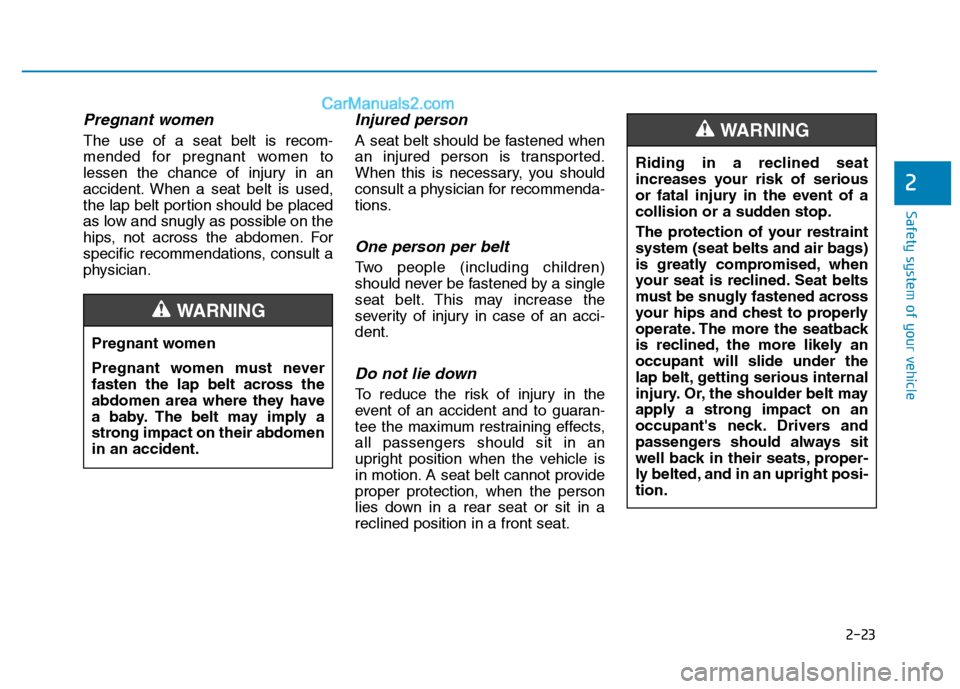
2-23
Safety system of your vehicle
2
Pregnant women
The use of a seat belt is recom-
mended for pregnant women to
lessen the chance of injury in an
accident. When a seat belt is used,
the lap belt portion should be placed
as low and snugly as possible on the
hips, not across the abdomen. For
specific recommendations, consult a
physician.
Injured person
A seat belt should be fastened when
an injured person is transported.
When this is necessary, you should
consult a physician for recommenda-
tions.
One person per belt
Two people (including children)
should never be fastened by a single
seat belt. This may increase the
severity of injury in case of an acci-dent.
Do not lie down
To reduce the risk of injury in the
event of an accident and to guaran-
tee the maximum restraining effects,all passengers should sit in an
upright position when the vehicle is
in motion. A seat belt cannot provideproper protection, when the person
lies down in a rear seat or sit in areclined position in a front seat.
Pregnant women
Pregnant women must never
fasten the lap belt across the
abdomen area where they have
a baby. The belt may imply a
strong impact on their abdomenin an accident.
WARNING
Riding in a reclined seat
increases your risk of serious
or fatal injury in the event of a
collision or a sudden stop.
The protection of your restraint
system (seat belts and air bags)
is greatly compromised, when
your seat is reclined. Seat belts
must be snugly fastened across
your hips and chest to properly
operate. The more the seatback
is reclined, the more likely anoccupant will slide under the
lap belt, getting serious internal
injury. Or, the shoulder belt may
apply a strong impact on an
occupant's neck. Drivers and
passengers should always sit
well back in their seats, proper-
ly belted, and in an upright posi-tion.
WARNING
Page 44 of 473
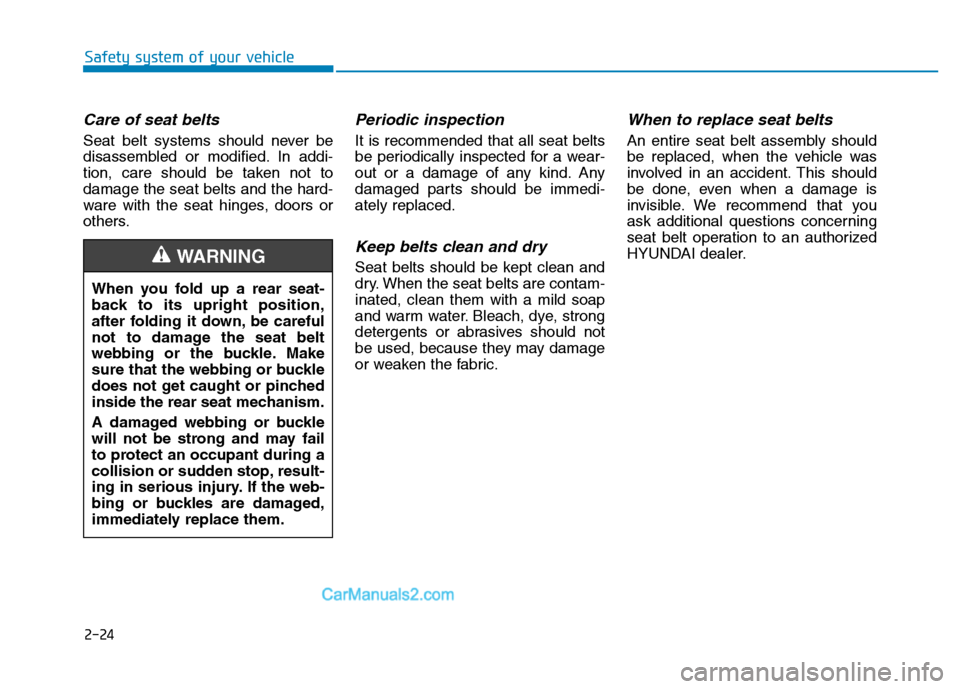
2-24
Safety system of your vehicle
Care of seat belts
Seat belt systems should never be
disassembled or modified. In addi-
tion, care should be taken not todamage the seat belts and the hard-
ware with the seat hinges, doors or
others.
Periodic inspection
It is recommended that all seat belts
be periodically inspected for a wear-
out or a damage of any kind. Any
damaged parts should be immedi-ately replaced.
Keep belts clean and dry
Seat belts should be kept clean and
dry. When the seat belts are contam-inated, clean them with a mild soap
and warm water. Bleach, dye, strong
detergents or abrasives should not
be used, because they may damage
or weaken the fabric.
When to replace seat belts
An entire seat belt assembly should
be replaced, when the vehicle was
involved in an accident. This should
be done, even when a damage is
invisible. We recommend that you
ask additional questions concerning
seat belt operation to an authorized
HYUNDAI dealer.
When you fold up a rear seat-
back to its upright position,
after folding it down, be careful
not to damage the seat belt
webbing or the buckle. Make
sure that the webbing or buckle
does not get caught or pinched
inside the rear seat mechanism.
A damaged webbing or buckle
will not be strong and may fail
to protect an occupant during a
collision or sudden stop, result-
ing in serious injury. If the web-
bing or buckles are damaged,
immediately replace them.
WARNING
Page 45 of 473
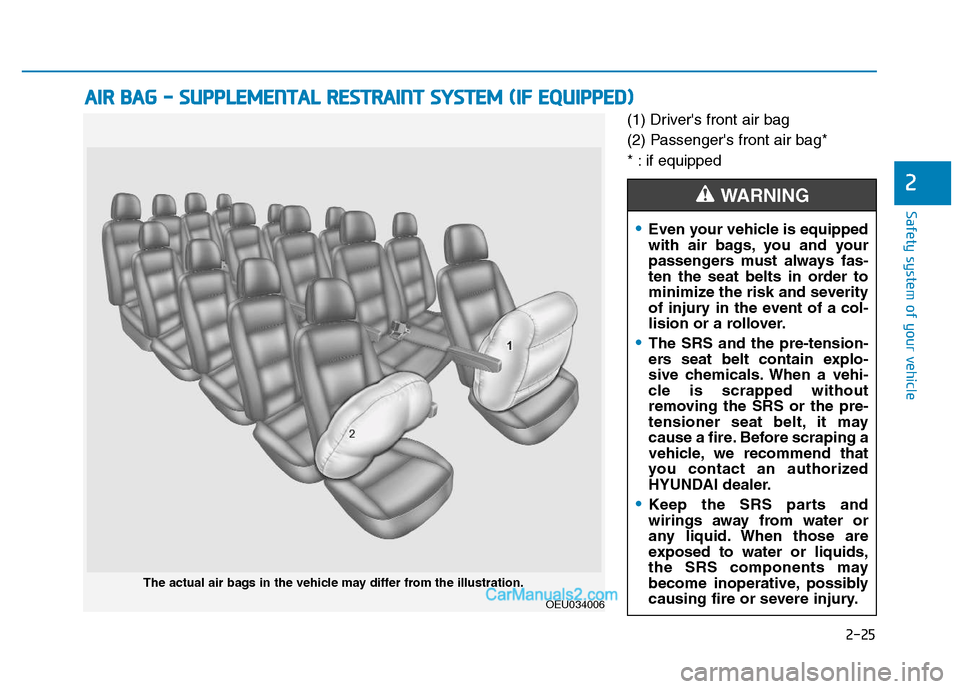
2-25
Safety system of your vehicle
2
(1) Driver's front air bag
(2) Passenger's front air bag*
* : if equipped
AAIIRR BB AA GG -- SS UU PPPPLLEE MM EENN TTAA LL RR EESSTT RR AA IINN TT SS YY SSTT EEMM (( IIFF EE QQ UUIIPP PPEEDD ))
OEU034006
The actual air bags in the vehicle may differ from the illustration.
Even your vehicle is equipped
with air bags, you and your
passengers must always fas-
ten the seat belts in order to
minimize the risk and severity
of injury in the event of a col-
lision or a rollover.
The SRS and the pre-tension-
ers seat belt contain explo-
sive chemicals. When a vehi-
cle is scrapped without
removing the SRS or the pre-
tensioner seat belt, it may
cause a fire. Before scraping a
vehicle, we recommend that
you contact an authorized
HYUNDAI dealer.
Keep the SRS parts and
wirings away from water or
any liquid. When those are
exposed to water or liquids,
the SRS components may
become inoperative, possibly
causing fire or severe injury.
WARNING
Page 46 of 473
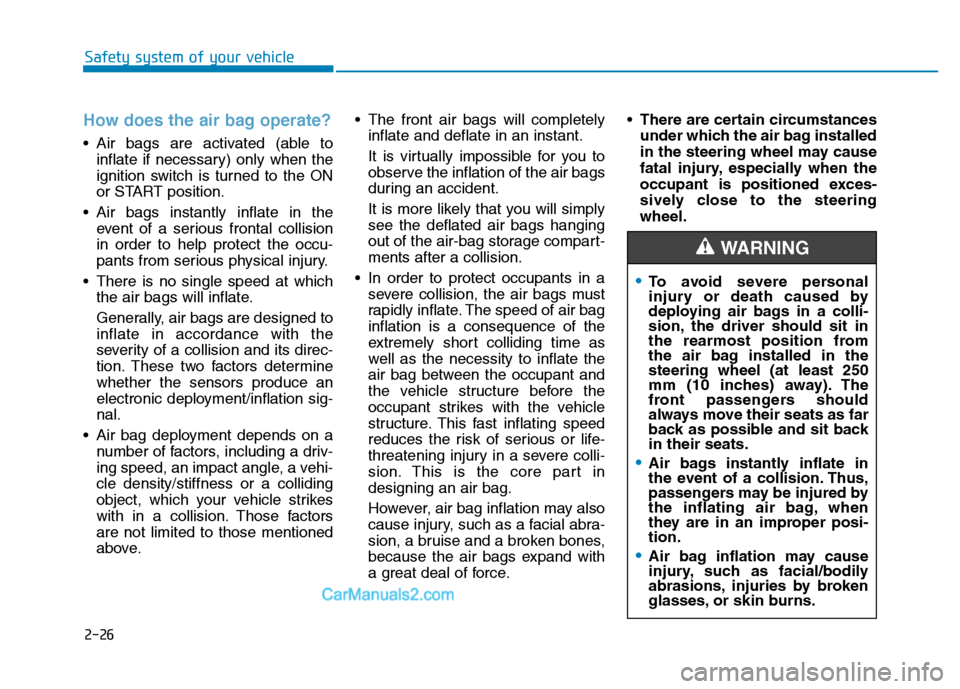
2-26
Safety system of your vehicle
How does the air bag operate?
Air bags are activated (able toinflate if necessary) only when the
ignition switch is turned to the ON
or START position.
Air bags instantly inflate in the event of a serious frontal collisionin order to help protect the occu-
pants from serious physical injury.
There is no single speed at which the air bags will inflate.
Generally, air bags are designed to inflate in accordance with the
severity of a collision and its direc-
tion. These two factors determinewhether the sensors produce an
electronic deployment/inflation sig-nal.
Air bag deployment depends on a number of factors, including a driv-
ing speed, an impact angle, a vehi-cle density/stiffness or a colliding
object, which your vehicle strikes
with in a collision. Those factorsare not limited to those mentioned
above. The front air bags will completely
inflate and deflate in an instant.
It is virtually impossible for you to
observe the inflation of the air bags
during an accident.
It is more likely that you will simply see the deflated air bags hanging
out of the air-bag storage compart-ments after a collision.
In order to protect occupants in a severe collision, the air bags must
rapidly inflate. The speed of air baginflation is a consequence of the
extremely short colliding time as
well as the necessity to inflate the
air bag between the occupant and
the vehicle structure before the
occupant strikes with the vehicle
structure. This fast inflating speed
reduces the risk of serious or life-
threatening injury in a severe colli-
sion. This is the core part indesigning an air bag.
However, air bag inflation may also
cause injury, such as a facial abra-
sion, a bruise and a broken bones,
because the air bags expand with
a great deal of force.
There are certain circumstances
under which the air bag installed
in the steering wheel may cause
fatal injury, especially when the
occupant is positioned exces-
sively close to the steeringwheel.
To avoid severe personal
injury or death caused by
deploying air bags in a colli-
sion, the driver should sit in
the rearmost position from
the air bag installed in thesteering wheel (at least 250
mm (10 inches) away). The
front passengers should
always move their seats as far
back as possible and sit backin their seats.
Air bags instantly inflate in
the event of a collision. Thus,
passengers may be injured by
the inflating air bag, when
they are in an improper posi-tion.
Air bag inflation may cause
injury, such as facial/bodily
abrasions, injuries by broken
glasses, or skin burns.
WARNING
Page 47 of 473
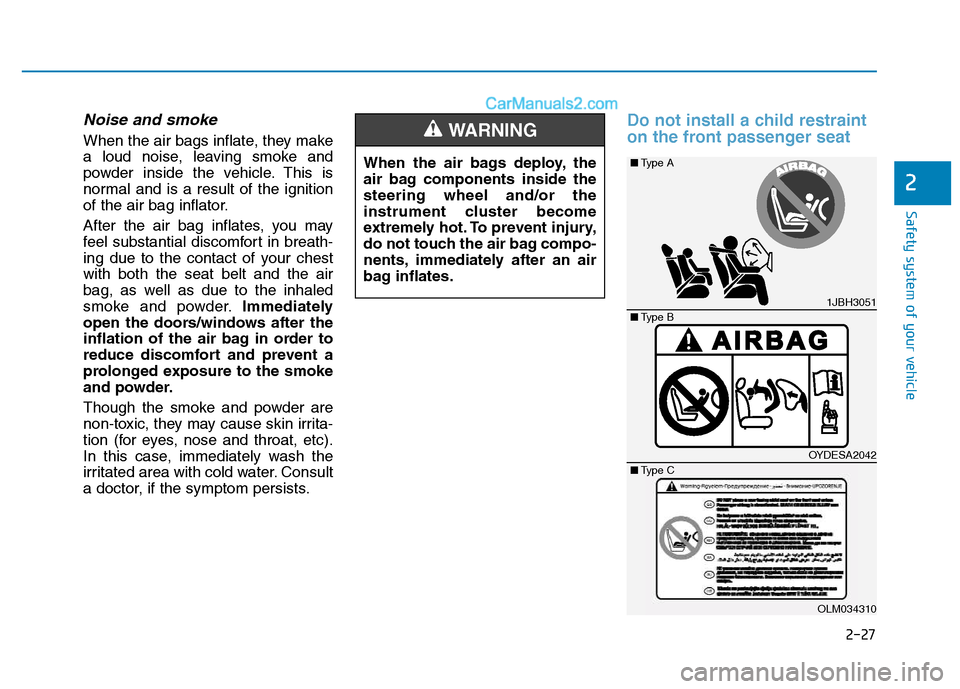
2-27
Safety system of your vehicle
2
Noise and smoke
When the air bags inflate, they make
a loud noise, leaving smoke and
powder inside the vehicle. This is
normal and is a result of the ignition
of the air bag inflator.
After the air bag inflates, you may
feel substantial discomfort in breath-
ing due to the contact of your chestwith both the seat belt and the air
bag, as well as due to the inhaled
smoke and powder.Immediately
open the doors/windows after the
inflation of the air bag in order to
reduce discomfort and prevent a
prolonged exposure to the smoke
and powder.
Though the smoke and powder are
non-toxic, they may cause skin irrita-
tion (for eyes, nose and throat, etc).
In this case, immediately wash the
irritated area with cold water. Consult
a doctor, if the symptom persists.
Do not install a child restraint
on the front passenger seat
When the air bags deploy, the
air bag components inside thesteering wheel and/or the
instrument cluster become
extremely hot. To prevent injury,
do not touch the air bag compo-
nents, immediately after an air
bag inflates.
WARNING
1JBH3051
OYDESA2042
OLM034310
■ Type B
■
Type A
■ Type C
Page 48 of 473
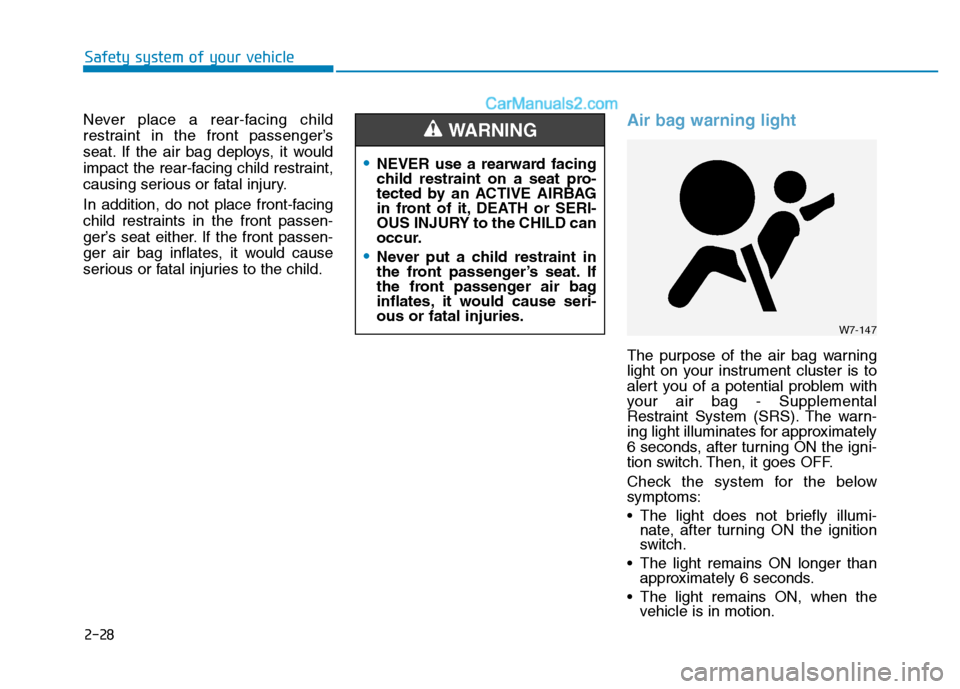
2-28
Never place a rear-facing child
restraint in the front passenger’s
seat. If the air bag deploys, it would
impact the rear-facing child restraint,
causing serious or fatal injury.
In addition, do not place front-facing
child restraints in the front passen-
ger’s seat either. If the front passen-
ger air bag inflates, it would cause
serious or fatal injuries to the child.
Air bag warning light
The purpose of the air bag warning
light on your instrument cluster is to
alert you of a potential problem with
your air bag - Supplemental
Restraint System (SRS). The warn-
ing light illuminates for approximately
6 seconds, after turning ON the igni-
tion switch. Then, it goes OFF.
Check the system for the below symptoms:
The light does not briefly illumi-
nate, after turning ON the ignition
switch.
The light remains ON longer than approximately 6 seconds.
The light remains ON, when the vehicle is in motion.
Safety system of your vehicle
NEVER use a rearward facing
child restraint on a seat pro-
tected by an ACTIVE AIRBAG
in front of it, DEATH or SERI-
OUS INJURY to the CHILD can
occur.
Never put a child restraint in
the front passenger’s seat. If
the front passenger air bag
inflates, it would cause seri-ous or fatal injuries.
WARNING
W7-147
Page 49 of 473
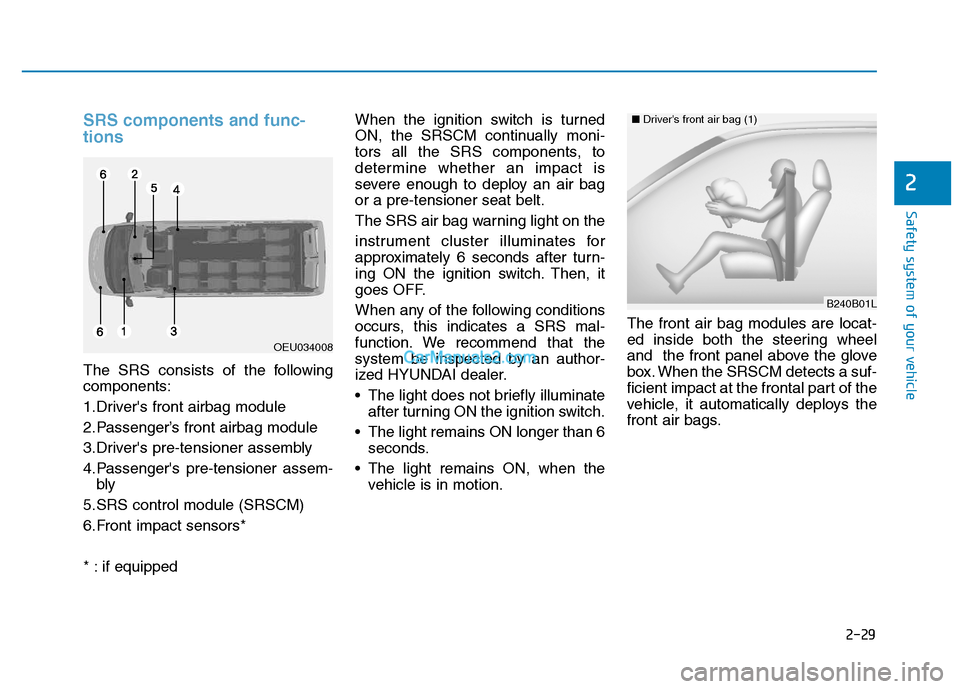
2-29
Safety system of your vehicle
2
SRS components and func- tions
The SRS consists of the following components:
1.Driver's front airbag module
2.Passenger’s front airbag module
3.Driver's pre-tensioner assembly
4.Passenger's pre-tensioner assem-bly
5.SRS control module (SRSCM)
6.Front impact sensors*
* : if equipped When the ignition switch is turned
ON, the SRSCM continually moni-
tors all the SRS components, to
determine whether an impact is
severe enough to deploy an air bagor a pre-tensioner seat belt.
The SRS air bag warning light on the
instrument cluster illuminates for
approximately 6 seconds after turn-
ing ON the ignition switch. Then, it
goes OFF.
When any of the following conditions
occurs, this indicates a SRS mal-
function. We recommend that the
system be inspected by an author-
ized HYUNDAI dealer.
The light does not briefly illuminate
after turning ON the ignition switch.
The light remains ON longer than 6 seconds.
The light remains ON, when the vehicle is in motion. The front air bag modules are locat-
ed inside both the steering wheel
and the front panel above the glove
box. When the SRSCM detects a suf-
ficient impact at the frontal part of the
vehicle, it automatically deploys the
front air bags.
OEU034008
B240B01L
■
Driver's front air bag (1)
Page 50 of 473
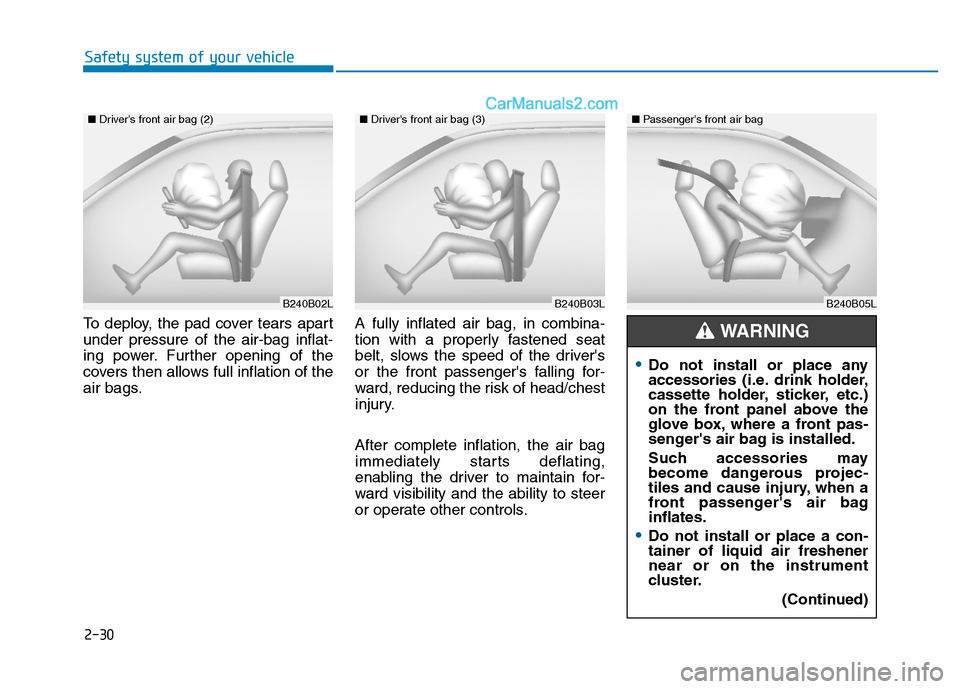
2-30
Safety system of your vehicle
To deploy, the pad cover tears apart under pressure of the air-bag inflat-
ing power. Further opening of the
covers then allows full inflation of the
air bags.A fully inflated air bag, in combina-
tion with a properly fastened seat
belt, slows the speed of the driver's
or the front passenger's falling for-
ward, reducing the risk of head/chest
injury. After complete inflation, the air bag
immediately starts deflating,
enabling the driver to maintain for-
ward visibility and the ability to steer
or operate other controls.
B240B02LB240B03L
■
Driver's front air bag (2)■Driver's front air bag (3)
B240B05L
■ Passenger's front air bag
Do not install or place any
accessories (i.e. drink holder,
cassette holder, sticker, etc.)
on the front panel above the
glove box, where a front pas-
senger's air bag is installed.
Such accessories may
become dangerous projec-
tiles and cause injury, when a
front passenger's air baginflates.
Do not install or place a con- tainer of liquid air freshenernear or on the instrument
cluster.
(Continued)
WARNING